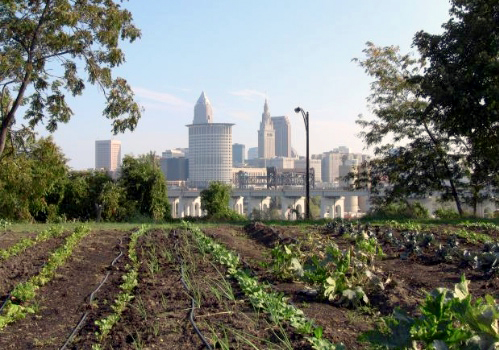

ThinkProgress
by Adam James
As concerns mount over the accessibility and quality of meals in cities, urban agriculture is becoming a practical solution to give communities more choice—all while helping address greenhouse gas emissions from centralized agriculture.
With more than 80 percent of the American population living in metropolitan centers, urban farming has the ability to dramatically enhance economic growth, increase food quality and build healthier communities.
The Problem: Carbon Intensive Meals
“Would you like some CO2 with that?”
The globalization of food has dramatically increased the amount of carbon emissions in our meals—particularly in America.
For example, food related emissions in the U.S. account for 21 percent of total emissions, or 6.1 tons of CO2 per year. Additionally, 15 percent of personal transportation emissions, 20 percent of home energy use emissions and 23 percent of the aggregate remaining activities are food-related as well. Add it all up and you find that our food choices make up a very large portion of our overall footprint.
Consumer activities like traveling to the grocery store, eating at restaurants, and cooking make up 46 percent of total emissions from food.
The other 54 percent of emissions come from the production, distribution and selling of food. This includes activities like packaging, storage and transportation. The average meal has traveled 4,200 miles just to get to the table. And at the end of the line, food related emissions account for 28 percent of all U.S. landfill gas emissions.
So what can be done?
The Solution: Urban Farming’s Wide Range of Benefits
There are already plenty of resources on the energy intensity of food and how to calculate the emissions from a given meal. But people—particularly those in cities living in “food deserts”—can’t act on this information if they don’t have the resources.
This is where urban agriculture comes in. Urban agriculture is defined by the Food and Agriculture Organization of the United Nations as:
“[A]n industry that produces, processes and markets food and fuel, largely in response to the daily demand of consumers within a town, city, or metropolis, on land and water dispersed throughout the urban and peri-urban area, applying intensive production methods, using and reusing natural resources and urban wastes to yield a diversity of crops and livestock.”
Basically, urban farming allows individuals or groups to establish gardens or mini-farms on small plots, using creative techniques to maximize, output, meet local needs and help make efficient use of the land. Gardeners are finding all kinds of ways to grow food: On rooftops, in abandoned buildings and on deteriorating plots of land.
These operations can help consumers lower their food emissions by giving them the choice to eat food grown within their communities, not thousands of miles away.
But that’s not all. In addition to offsetting emissions, there are at least three concrete benefits to urban farming: economic growth; community building; and improved health.
Economic Growth
The economic benefits realized through urban farming are localized, thus keeping dollars circulating through the community. These urban farms also have a fantastic return on investment, with every $1 invested in a community garden generating $6 worth of vegetables.
And these community food enterprises are actually competitive with big-box retailers. As one report puts it:
“In recent years CFEs have discovered that they actually have unique advantages over bigger companies. They have a deeper awareness of local tastes and markets, they can obtain consumer feedback more quickly, and they can tweak their business models more swiftly. They can deliver goods and services faster, with shorter distribution links and smaller inventories. They can rely more on word-of—mouth advertising that costs nothing.”
These projects can be structured in unique ways to encourage greater economic impacts in communities. For example, Food From the ‘Hood turned an abandoned football field into a 2 acre farm, with 25 percent of the proceeds going to a scholarship fund for local youth in South Central Los Angeles. To date, $250,000 has gone to sending youth in the community to college.
Furthermore, in low-income communities, where food costs can be as much as 30-60 percent of income, localizing food can help stabilize food costs.
Community Building
In 2010, a total of 14.5 percent of households were food insecure, with a further 5.4 percent experiencing “severe” food security.
Community health is, as one report describes it, “the social and economic capacity of a community to create an environment that sustains the visions, goals and needs of its residents.” Increased food security is a crucial component to realizing this vision.
The social organization required for most urban farming projects can forge stronger community bonds by creating “stakeholder interactions” that give individuals a sense of responsibility and productivity. By harnessing two sources of capital—social capital and the existing built environment—urban farming uses the inherent strengths of cities to solve some of their most serious problems.
Food Quality and Health
Studies have shown that nutrition, exercise, and mental and physical health are all augmented with urban farms.
In temperate climates, a 10’ x 10’ garden can feed a family of four year-round and meet almost all basic nutritional requirements. This solves the directly related problems food insecurity and poor nutrition. The act of gardening is also great exercise that improves physical health: reducing risk of obesity, heart disease and diabetes. The act of cultivation has significant impact on mental health as well—assisting with social skills, self-esteem improvement and stress reduction.
Bringing It Home
The impact of urban farming on local communities and families is undeniable. While this activity gains traction in cities across the country, the potential for reducing our food related emissions continues to grow—all while helping improve the economic and social dynamics of the urban environment.
——–
Adam James is a Special Assistant for Energy Policy at the Center for American Progress.
Visit EcoWatch’s SUSTAINABLE AGRICULTURE page for more related news on this topic.

 233k
233k  41k
41k  Subscribe
Subscribe 